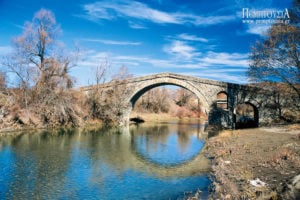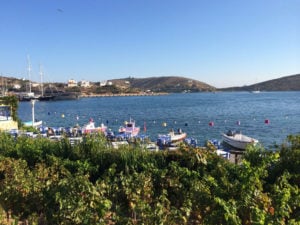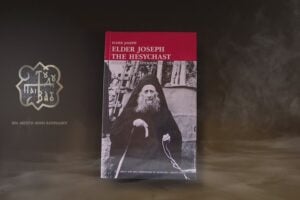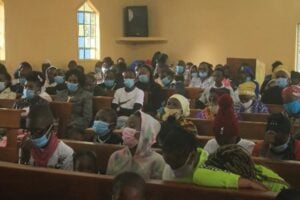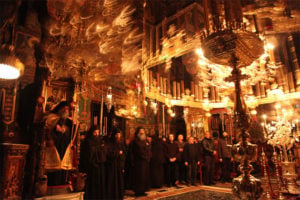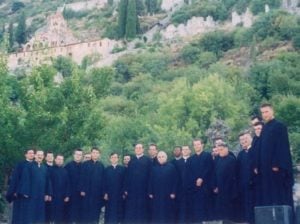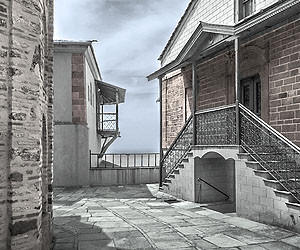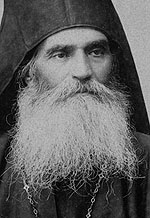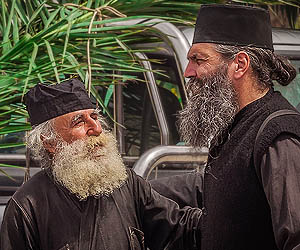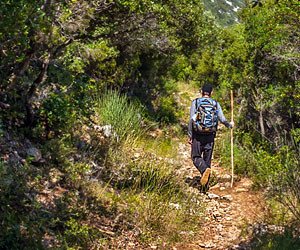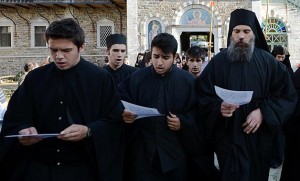Blessed Contemporary Elders of Athos
7 November 2011A fragrant account of charming Elders with serene and luminous faces who have lived in the Garden of the Virgin Mary in recent times. A strong and tightly linked chain of men who, in an age so easily criticised for its spiritual poverty, have preserved the ascetic, humble and mystical character of the virtuous life in a marvellously bold, courageous and heroic manner, out of a great love for God and with no expectation of human reward.

The New Skete was home to Elder Elpidios from Nicosia in Cyprus. He was a passionate adherent of the principle of ‘glorious ingloriousness’ and constantly practised the principle of lathe biosas. He would speak highly of others in order to divert attention away from himself. In this photograph he appears together with his outstanding fellow ascetic, Father Eustathios.
I am always moved by the sight of little old monks on the Holy Mountain, with their pale complexions, stooping gait and venerable, truly humble demeanour; men who always walk slowly, never rush and do not wear watches, regulating their daily tasks by the position of the sun in the sky. Unassuming men, men who stand out for their moderation, discernment, sobriety, uprightness, sincerity, kindness and goodness.
Men who stand out for their sincere and heartfelt chanting both on normal days and feast-days and their profound understanding of church ceremony and ritual. Most striking of all is their attitude and demeanour during Holy Communion, when they are particularly attentive and display great piety, awe and fear of the Lord, their faces luminous and serene, with a clear gaze. Whenever they said ‘evlógison’, ‘evlogeíte’ or ‘nánai evlogiméno’1 they meant it, they felt it and really spoke from the heart. This was particularly true during Pentecost, when they would cry ‘Christós anesti’ or ‘Alithós anesti’.2
Elder Theoktistos Dionysiatis: the monk who talked with the saints
‘I love being in church,’ Elder Theoktistos of Dionysiou (†1995) would say with conviction. A son of Epirus, that land of ‘good and true men’, Elder Theoktistos talked with the saints. ‘When I am in church all my troubles disappear.’ He would sit for hours on end in the narthex, with its marvellous frescoes of the Apocalypse, prayer-rope in hand. He asked me to write a book about the saints from his native region. In the end somebody else wrote one and he was very pleased. He spent almost forty years at the monastery moving between his small basement cell and the intensely penitential atmosphere of the katholikon.4 Theoktistos, who had a great love for the saints, God and his fellow monks and was an avid attender of church services, had a spontaneous piety and a mystical kind of virtue. The blessed Elder used to say, ‘I was far away from God but the Virgin Mary took pity on me. I fell seriously ill, and I asked her to make me well. I was healed and I became a monk. I won the top prize in the lottery.’ Once he said to some pilgrims who were friends of his, ‘Sometimes I sit opposite the Virgin Mary – in the chapel which contains the wonder-working icon of the Virgin Mary of the Akathist Hymn – and she eases my pain. I go to the Chapel of the Anargyroi and my stomach settles’.
Father Vlassios the Simple and Elder Arsenios, the quiet cultivator of virtue, of Dionysiou Monastery
At the Monastery of Dionysiou I also met Father Vlassios (†1992). Many probably regarded him as a dimwit or a simpleton. In my humble opinion, he was merely a simple man. I can vouch for his blessed simplicity of character as I have vivid memories of the attitude he struck during a celebration of the Divine Liturgy in the katholikon. He was sitting in a stall near the back of the dimly-lit church about two hours before dawn, with his head bowed down and his ascetic face covered by his veil, as if he were hearing the Divine Liturgy for the very first time, like a young novice.

‘In his blissfully simple way Father Vlassios of Dionysiou Monastery was sitting in a stall near the back of the dimly-lit church about two hours before dawn, with his head bowed down and his ascetic face covered by his veil, as if he were hearing the Divine liturgy for the very first time.’ Father Vlassios is portrayed in the photograph above.
With an air of wonder, his mouth wide open, he was gazing at the Royal Gates, the priest and the icon of the Virgin Mary. Almost motionless and dumbstruck, he followed the proceedings with a sense of awe. He was a humble man who dearly loved the prophesies of St. Kosmas the Aetolian and expounded them in a delightful way. He was good-hearted and handed out ‘artistic’ copies of the great saint’s prophesies to pilgrims, drawing their attention to the importance of preserving Orthodox Tradition. He was, I repeat, a simple man and you knew where you stood with him. He lived simply, in poverty; he was a fine, true and sincere man.
In its tombs and ossuary the Holy Monastery of Dionysiou preserves the bones of many blessed Elders, both known and unknown. These include Elder Arsenios of Pontus (†1983), a fellow ascetic and lifelong brother-in-arms of Elder Joseph the Hesychast (†1959) and later spiritual companion of Father Charalambos, abbot of Dionysiou Monastery (†2001). I only got to know him a little but, according to his spiritual brother Elder Joseph of Vatopedi, he was always a simple, gentle, upright, guileless and obedient man, a rare breed of spiritual warrior, a correct, vigilant and well-disposed individual who was noted for his quiet cultivation of virtue. Indeed, he always obeyed his Elder willingly, and not in a perfunctory, half-hearted way. He loved to fast constantly, eating either only once a day or frugally or selectively. He was fond of sleeping little and keeping long vigils every day, and he did not do it grudgingly but joyfully. He was often found at daybreak making prostrations or praying with his prayer-rope and he would say, ‘How early the sun has come up…!’

Father Charalambos of Dionysiou Monastery in his last cell, which St. Nephon, Patriarch of Constantinople, had once occupied when he was still a monk at the monastery. According to tradition, the Lord Himself appeared to the saint before the fresco of Christ while he was at prayer.
Father Paul, a tireless celebrant of the Eucharist, and Elder George, a courageous spiritual warrior, of St. Paul’s Monastery
Many benevolent old monks live under the Virgin Mary’s care and protection in her Athonite garden. At St. Paul’s Monastery, which lies near the Monastery of Dionysiou, I shall dwell on two less well-known contemporary fathers, who, although I scarcely knew them, had a very beneficial influence on me.
One of these was Father Paul (†1995), who came from Alexandria in Egypt, a well-educated and well-instructed man, a dear brother with a pure Orthodox outlook and an authentic Athonite ethos whose sudden passing greatly saddened many people. According to the highly venerable abbot of St. Paul’s Monastery, Parthenios, Father Paul served his monastery tirelessly for thirty-two years, officiating daily at the Holy Altar for three succcessive decades. He served the monastery and all his brethren with great joy. During the offertory he would commemorate the names of thousands of souls, both departed and living, known and unknown. He bore a special affection for the Virgin Mary, whose help he invoked constantly. He once wrote to an acquaintance of his, ‘Humility and perseverance will win in the end and will move the Lord to pity, while confession with a good spiritual father will put the enemy to shame and humble the ego’.
The other one was Elder George (†1998). His spiritual struggles at the coenobium lasted for six decades. Right up until the end of his life he always remembered what the blessed and virtuous abbot of Gregoriou Monastery, Athanasios (†1953), had told him about exile, abstinence and penury. During the Nazi Occupation he managed to help some Allied soldiers escape and for this reason was sentenced to death. With the help of the monastery’s patron saints, he was set free and returned to his beloved monastery, where he lived the life of an inconspicuous ascetic, far removed from admiring gazes and flattery. He was a brave spiritual warrior, with ancient monastic principles that he unfailingly observed, despite the strenuous effort required, which some could not understand. He passed away blissfully whilst at prayer in his humble cell.
Elder Elpidios of the New Skete, a passionate adherent of ‘glorious ingloriousness’
The nearby New Skete has been the home of many holy figures in the past, and continues to be so today. I shall dwell only on one of these unforgettable figures, who made a particularly good impression on me. This was the blessed Elder Elpidios (†1983), who was born in Nicosia on Cyprus in 1913. As a young man he lived as a monk at the Monastery of Stavrovouni and then later in Jerusalem. For many years he worked as a spiritual father in Athens and acquired many spiritual children. For the last decade of his life he led a humble existence in a kalyva5 at the Skete of the Annunciation of the Mother of God. He was a twin brother of the hieromartyr Philoumenos of Jerusalem (†1979). Praising his outstanding fellow ascetic, Father Eustathios (†1979), and stressing the value of the virtue of humility of which the latter was such a fine example, he said that Father Eustathios was so rich in humility because, despite the fact that he was a great preacher and an illustrious cleric of the Archdiocese of Cyprus, during his three-year stay at the skete he came to love silence and obscurity – the principle of lathe biosas.6 Father Elpidios himself was a passionate adherent of the principle of ‘glorious ingloriousness’ advocated by St. Gregory of Nazianzos, and constantly practised the principle of lathe biosas. He would speak highly of others in order to divert attention away from himself. He would praise his brother’s blessed end and holy life, the piety of his good parents, the chaste traditions of Cyprus, the struggles and anxieties in Jerusalem, and his time at the beautiful New Skete.
Father George at the Cell of St. George Phaneromenos, a dependency of Pantokrator Monastery
One day, when I was alone in the konaki7 of Simonopetra Monastery in Karyes, I was visited by a little old monk whom I did not know at the time and who made an unexpected impression on me. He brought something for the Simonopetra representative. I can’t remember what it was: either chestnuts, hazelnuts or walnuts. He went into the kitchen and sat down shyly at the table – at the end, timidly, as if he were afraid and talking to somebody important. I offered him some raki, Turkish delight, coffee and water. He sipped a little from each drink but left the Turkish delight. He had a wonderful humility about him. He looked down and spoke quietly and little. He sat with his feet together, his lean and slightly hunched body drawn in, clad in a short soutane, faded outer cassock and an old tightly drawn belt.

Elder Joachim of Karyes dearly loved Christ, the Virgin Mary, the Holy Mountain, ascetic practice, study and prayer.
When he held the glass or cup his hand seemed to shake. He didn’t have Parkinson’s Disease: I think he would have done the same even on his own. I asked him which cell he was from. He was from the cell of St. George Phaneromenos (‘the Revealed One’), a dependency of Pantokrator Monastery, above Kapsala. St. George was a guardian of borders. The old monks used to say that Karyes begins at the cell of St. George below Koutloumousiou Monastery, where Elder Chrysanthos used to live, and ends by the cell of St. George Phaneromenos, who once appeared on this site and worked miracles. My unexpected interlocutor, whose last movement I can still recall even though it was a long time ago, was Father George (†1982), the last in a long line of blessed Elders. He had great reverence for his patron saint and with characteristic simplicity would relate the miracles that had happened to him and his fellow Elders. He often repeated what the venerable Elder Pachomios (†1974) had said about his end: that he would pass away at the age of eighty. That is exactly what happened. He had prepared his grave some time before and took leave of the fathers by saying, ‘I’m going to die this year. My spiritual father told me so.’ His spiritual father was Elder Evlogios from Euboea (1840-1948), who had been instructed by the Virgin Mary to go to her Garden and become a novice under the renowned Athonite ascetic Hadji-Georgis (†1886) at Kerasia. Elder Evlogios was very strict with himself but lenient towards others. He never left Athos. For thirteen whole years he abstained from any kind of food prepared with olive oil. On many occasions he was attacked by demons, which he managed to repulse through the power of fervent faith and prayer and a pure and humble heart. The same thing happened to Fathers Pachomios and George.
One could mention the individual links in a whole line of holy figures, a strong and tightly linked chain of men who, in an age so easily criticised for its spiritual poverty, have preserved the ascetic, humble and mystical character of the virtuous life in a marvellously bold, courageous and heroic manner, out of a great love for God and with no expectation of human reward.
The charming Elder Joseph from Cyprus
I shall always remember my neighbour, Elder Joseph from Cyprus (†1992), who had been at our skete for sixty years and who, at a vigil on the feast of the Holy Apostles at Karakalou Monastery (the monastery’s patronal festival), saw St. Paul preach to him… the Great Martyr and Healer St. Panteleimon heal him… and the Virgin Mary tend to his needs… A relative of his in America once sent him some dollars and heretical pamphlets and he sent them back, saying that only the Orthodox hold the truth. ‘The loveliest book in the world is the Psalter. What wonderful things it says. God speaks to us. He found a man after His own heart, it says: David. Have you heard the words that God has spoken? The Psalter, the Gospel Book and the Apostolos8: those are the three books I like. They are the most important in the Church. I’ve got other books, like saints’ lives, which I’ve read over and over again. I don’t like these new books that priests are writing… Praise be to God! I’ve got a lot to tell you but it’s hard for me now, my memory fails me, brother. Praise be to God!’

Elder Joseph of Cyprus from the Skete of Koutloumousiou, who, during a vigil on the feast of the Holy Apostles, saw St. Paul preach to him, St. Panteleimon heal him and the Virgin Mary tend to his needs.
During the thirty years that, by God’s good grace, I have been on this most sacred Holy Mountain, I have known many charming old monks. Elder Barlaam of Xenophontos (†1983), who passed away at the age of 110 and was blessed with a humility and forbearance that were pleasing to God, and a divinely-taught obedience. Abbot Athanasios of the Great Lavra (†1984), with his truly genuine humility, exemplary patience and Gospel-like forbearance, his constant and tireless service, and his constant tolerance, gentleness and kindness. The Elder Joachim of Karyes (†1988), who dearly loved Christ, the Virgin Mary, the Holy Mountain, ascetic practice, study and prayer. The insignificant and unsung Elder Timotheos of Stavronikita (†1989), who concealed his virtue with his studied pretence of ‘foolishness’, although sometimes the truth shone through… The tranquil, noble and virtuous Arsenios of Gregoriou (†1991), who was so devoted to the Virgin Mary and the saints. The blessed Elder Sophrony (†1993), the superb biographer of St. Silouan of Athos and a man of pure-hearted prayer, assiduous noetic meditation and exalted theories and experiences. The lean and hunchbacked hieromonk John the Romanian (†1996) of Kolitsou, with his great piety, discernment and goodness. The ascetic, abstemious and patient Father Isaac from the Lebanon (†1998), a good cantor and spiritual father. The extremely long-lived Hesychios of Gregoriou (†1999), a model coenobite in both obedience and service. The quiet and saint-loving spiritual father Evdokimos of Vatopedi (†2003), the prior of the Skete of St. Demetrios who knew when to speak and what to say, when to keep quiet, to smile, to counsel, to give way, to wait, to pray and to withdraw.
There are many others about whose small and humble struggles, virtue and salvation I have written and will write again, even if only a few words; men whose names have been written in heaven and whose reward will be great, a hundredfold. May their prayers always be with us. We need them in these difficult times.
TRANSLATOR’S NOTES
1 Evlógison and evlogeíte = ‘bless’ (usually spoken in asking a hieromonk, priest or cleric of higher rank for a blessing); nánai evlogiméno = ‘may it be blessed’.
2 Christós anesti! = ‘Christ is risen!’, the traditional Greek Orthodox Easter greeting, to which the response is Alithós anesti! = ‘He is risen indeed!’.
4 The main church of a monastery.
5 A house forming part of a skete.
6 ‘Live unobtrusively’ – a motto of Epicurus.
7 A building providing accommodation for representatives from the Athonite monasteries.
8 A lectionary containing readings from the Gospels, the Acts of the Apostles and the Epistles of the Holy Apostles, as they are read in Orthodox Church services throughout the liturgical year.

